





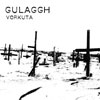
[SXIIICD005]
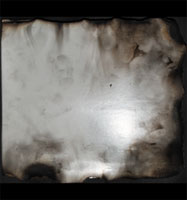
LDRTFS
'Alone With God'
[SXIIICD004]
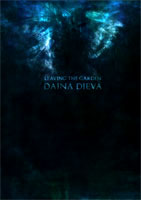
DAINA DIEVA
'Leaving the Garden'
[SXIIICD003]
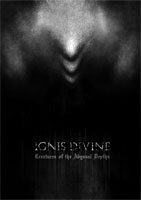
IGNIS DIVINE
'Creatures of the Abyssal Depths'
[SXIIICD002]
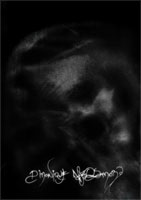
D'MONIQUE VELSMORD
[SXIIICD001]
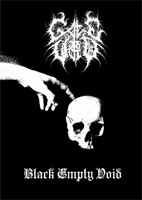
GATE TO VOID
'Black Empty Void I'

Following releases:
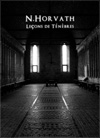

Production ov...
Lamia Culta "Woman Scarred" CD
Codices Infernales "Morsus Diaboli" by V.Scavr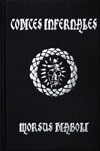
Demogorgon - Alphabetum Stygium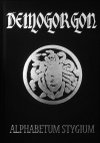
Azzier Lostname Spineola Snake «Чёрные Стихи»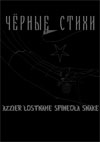
Signifer "Fleshes of My Livid Everything"
Necrosis XIII
Wholesale prices.
Production of audio media.
Templatesfor production.

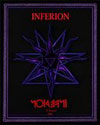




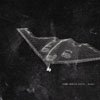
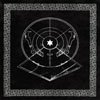
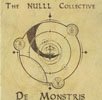
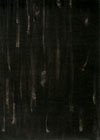


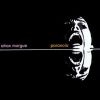




[SXIIICLP13] SPECIAL EDITION
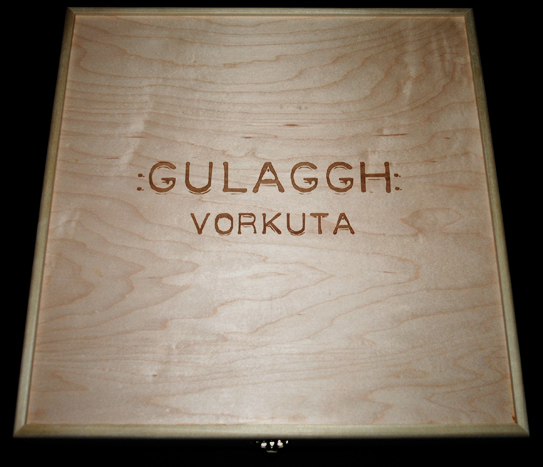 Pre-order Date: 27 January 2012
Pre-order Date: 27 January 2012
Release Date: March 2012
Edition: 13 Wooden boxes.
Complete Packaging: 12" LP housed in black 300gsm art paper sleeve with bone attached at the front + pyrography artwork on wood blank + exclusive drawing by mental patient + black tshirt + set of 32 unique postcards + greetings card, all packed in laser engraved wooden box.
SOLD
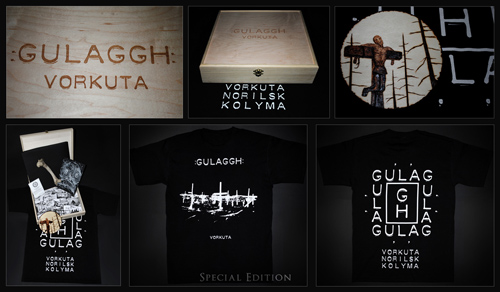
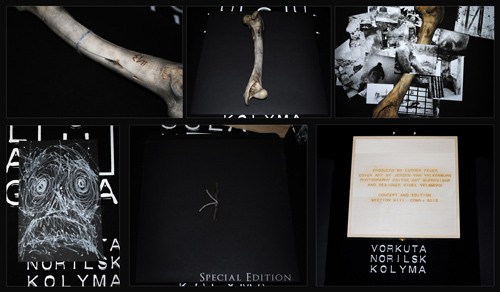 [SXIIICLP13] BLACK EDITION
[SXIIICLP13] BLACK EDITION
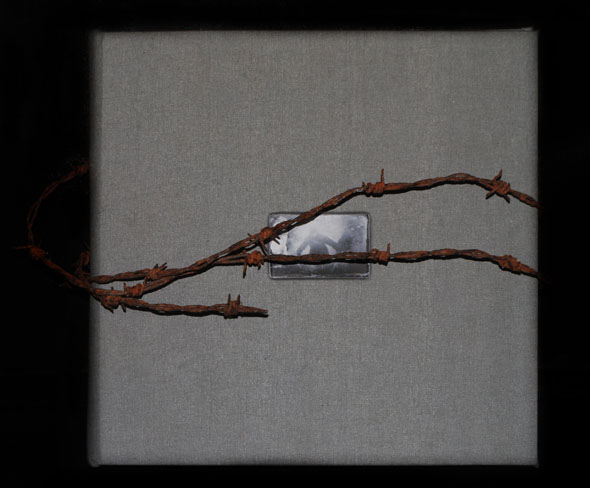 Pre-order Date: 27 January 2012
Pre-order Date: 27 January 2012
Release Date: March 2012
Edition: 32 Hard cover cases.
Complete Packaging:12" LP fixed onto bolt that pierces through the grey vinyl size hardback case with unique postcard on the cover + exclusive drawing by mental patient + grey tshirt + greetings card, all wrapped with rusted barbed wire.
SOLD
 Pre-order Date: 27 January 2012
Pre-order Date: 27 January 2012
Release Date: March 2012
Edition: 250 standard copies
Complete Packaging: 12" LP packed in vinyl sleeve.
€13
[postage and packing prices included]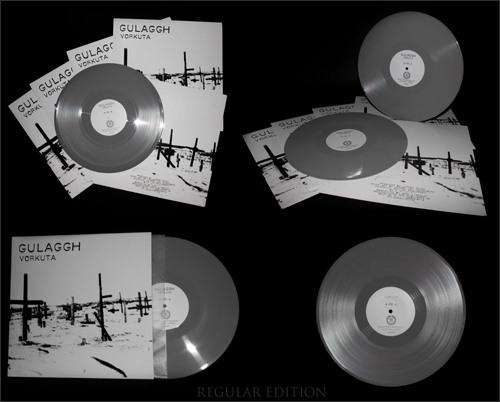 [SECT13C01] SECT EDITION
[SECT13C01] SECT EDITION
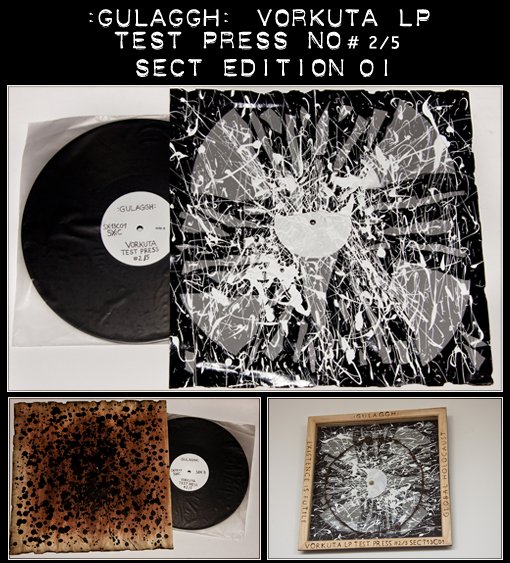
Introduction to Sect Edition. Extremely rare collectors editions / items on demand. Vorkuta Test press No.#2 / 5 is SECT13C01. Only 5 test press copies of this LP exist, 3 of which are owned by STALAGGH and are not for sale.
Test Press housed in hand painted sleeve that was varnished and decorated with pieces of broken regular LP (from copies damaged and broken in transit from pressing plant) and white gesso. Title, test press no and edition is handwritten on the label, both A and B sides.
The bolt is pierced through the envelope and attached to the back side of framing to fix vinyl. Rusted barbed wire placed inside in a circle measuring approx 30cm in diameter, fixed to the spacer with thick grey thread. All exterior sides of wall mount frame are burned with pyrography tool. Front side of the frame include burned wording:
:GULAGG: - EXISTENCE IS FUTILE - GLOBAL HOLOCAUST - VORKUTA LP TEST PRESS #2/5 SECT13C01
Frame measurements: 40x40x3cm. Placed for online auction and active for 10 days. SOLD
[SECT13C02] SECT EDITION
:GULAGGH: VORKUTA LP
TEST PRESS No# 5/5
SECT EDITION 02
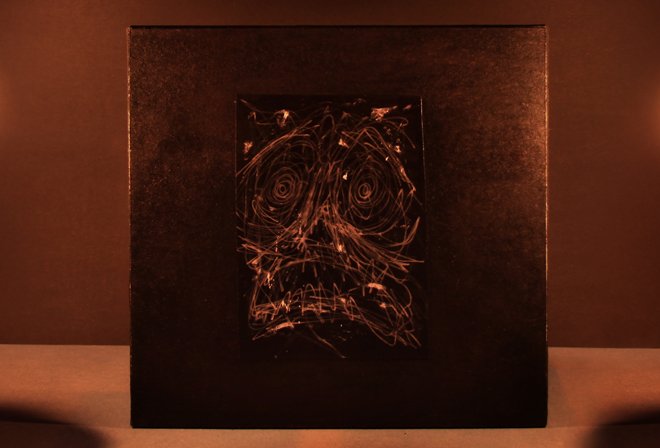
First, this isn’t music. There’s music in here; well, there are musical instruments that are being struck, beaten, or farted through at least. This, as the “band” describes their aural pieces, is “Misanthropik Nihilistik Audio-Terror”. In a previous incarnation, this collection of allegedly top musicians from the Dutch and Belgian black metal / industrial scene were known as Stalaggh, their name referencing the Nazi POW concentration camps that informed their trilogy ‘Projekt Nihil’, ‘Projekt Terrror’ and ‘Projekt Misanthropia’. The ‘gh’ stands for “Global Holocaust” and features as an addendum here for their ‘Gulaggh’ “projekt”, again another trilogy, this time based on Soviet Union work camps. And whatever Stalaggh / Gulaggh have chosen for their subject, controversy has long been their shadow. Apparently, the “band” have, in the past, recorded the screams of patients from mental institutions (including ex-prostitutes, rape victims, and patients in children’s asylums) for their work (legally, allegedly) as they wanted the pain and suffering to be real and not acted. They needn’t have bothered. They could’ve recorded me having to listen to this shit instead.
Opening with a recording of Stalin ordering his enemies to be sent off to the camps, the next three quarters of an hour consists of ever-mounting tortured screams and off-key music scattered across a hellish soundscape designed to recreate the experience of the Soviet Union Gulag camps. On the first listen, the depiction of the ever-mounting torture is more a surprise than a shock and so the intended effect is achieved, to some extent at least. The effect rapidly diminishes and the listener soon numbs to it. Just like the soldiers in the camp would have been numbed by the endless pageant of torture that they were exposed to on a daily basis; just like we have become numbed by the portrayal of war to war itself; just like we have become numbed by the depiction of violence to violence itself; just like we have become numb to capitalist ideology and the numb reproduction of that ideology. Etc., etc., etc…
Stalaggh’s rebranding as Gulaggh is a masterstroke in deception. There’s nothing new here. Give one listen to any one of the Stalaggh works and you’ll hear the same merry medley of escalating screams and discordant instrumentation. The album’s subject is irrelevant because it is its form that is at its core, and its form is the manipulation of style for its effect. That I’ve spent more time thinking about the album and what to write in this review than listening to this shit is testament to its effect. Art is supposed to make the listener think about its subject and its relevance, or irrelevance if you like. ‘Vorkuta’ – as do all of Stalaggh/Gulaggh’s works – signifies the futility of existence, of existential angst, of the absurdist notion of deriving meaning from a meaningless world. Caught in an endless cycle of regurgitation disguised as production and creativity, this is our (post)modern condition. Limited edition or specially packaged copies of this will soon be (or possibly already are) selling on e-bay for ridiculous amounts, no doubt with elitists battling it out for the possession of cultural capital. But no one will listen to this more than once alone. This will be no more than an ornament atop the fireplace, a discussion piece for pseudo-intellectuals everywhere. Just like this fucking review…
[Review by Jason Guest @ metal-discovery.com]
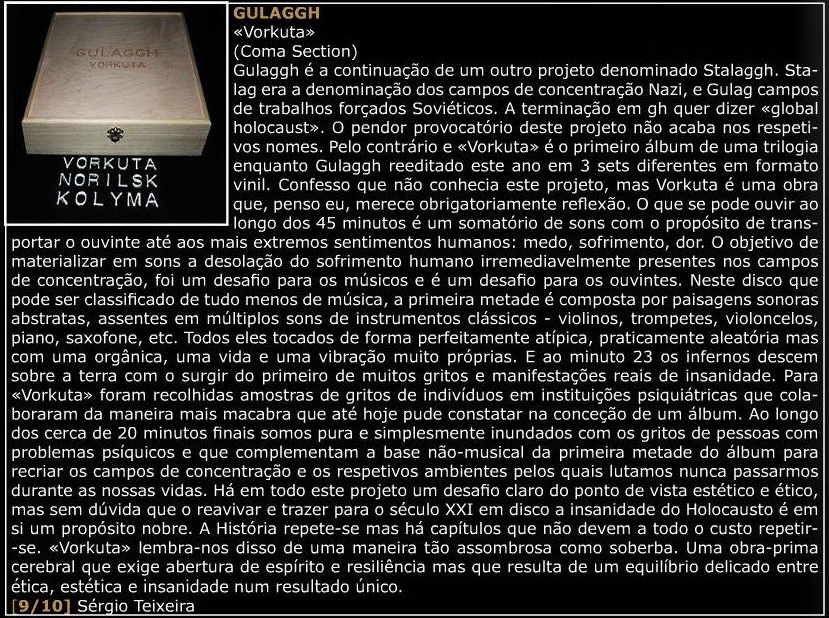
[Review by Sergio Teixeira @ Versus Magazine (no.24)]
Well, where do you start with something like this? Incredibly tough to categorise, my best description would be Audio-Horror. In an interview they described themselves as ‘Audio-Terror’ but I think that ‘horror’ is a more accurate representation. ‘Terror’ seems far too short and sharp whereas ‘horror’ alludes more to a gradual but unrelenting build up of true fear and disgust. That is what this album is; frighteningly disgusting. I can only imagine that the idea of this is to conjure images in the mind of what it would be like to be suffering as people did in those horrible Arctic torture gardens. It really is nasty stuff.After completing three albums under the name Stalaggh, this group of ‘musicians’ decided to change their focus from concentration camps to the equally disturbing idea of Soviet Gulags, hence the name (they kept the GH suffix, standing for Global Holocaust). The premise is relatively similar; to evoke an unending wave of negative emotions using a basic noise/ambient track over intermittent spasms of music all topped off by screams of the mentally insane. That’s not a metaphor. The vocals on these albums are actually the recorded screams of patients with severe mental disorders. An interesting accomplishment, since one wonders how this group of anonymous ‘musicians’ managed that. Information from one of a limited number of interviews with one of the core members (who also provided some of the vocals) explains that some of the patients were allowed to leave for a few days but that some of them live under their own guidance and are free to do as they please. Not quite as impressive as the legend surrounding their last album of them kidnapping mental patients and recording their screams in a church, telling the Vicar that it was some sort of ‘scream therapy’. The man specifies that ‘they are not retards’ but suffer from disorders such as schizophrenia, psychosis, multiple personality disorder etc. Knowing that the screams are really pulled from the depths of pain and disorder really does make for an incredibly uncomfortable listening experience, especially with the single track album spanning a relentless 45 minutes.
Progressing slightly from the last Stalaggh instalment of Projekt Misanthropia, the sound has changed subtly yet somehow quite dramatically. The sound is much bigger as they have decided to use the screams of many more patients and brought in a few more musicians to throw in their random two cents. Completely abandoning the Black Metal aspects that they used in earlier offerings in favour of a more chaotic traditional marching band they really have managed to capture audio-PAIN.
There is something quite cathartic about listening to this album and it is actually quite enjoyable if you like exploring the darkest depths of your own mind. However this is not for the faint of heart or head, you will not enjoy this or probably even see a point in this if you keep your mind closed to the idea of experiencing the extremes of negativity in your own consciousness. I would recommend getting a hold of this album just for the experience, even if you listen to it only once and then brag about how ‘Kvlt’ your last album buy was to all your friends.
Try it. I dare you.
So mancher hat sicherlich schon einmal den Namen Stalaggh vernommen und ich erinnere mich mit Schrecken an jenen Müll, der sich damals in meiner Anlage wiederfand. Nachdem man die Trilogie unter diesem Namen abgeschlossen hatte, gebar man ein neues Monster: Gulaggh.
Vielleicht sollte ich am besten damit beginnen, was Gulaggh von Stalaggh unterscheidet. Stalaggh steht für unerträglich schlechten Noise und ist lediglich eine Beleidigung für all die, welche mit ihrer Musik auch etwas erreichen wollen. Ich spreche nicht von Ruhm, sondern Anspruch und Können. Weitere Worte sind einfach pure Verschwendung, also kommen wir zu diesem hässlichen Teil.
Gulaggh ist unerträglich. Unerträglich langweilig, fernab von Musik, Melodien und Rhythmen. Oder soll es tatsächlich ausreichen, minutenlange Lautsprecherdurchsagen, schreiende Menschen und taktloses Getrommel als etwas Anspruchsvolles zu verstehen?
Die Info, dass hier eigentlich nur klassische Instrumente wie Geige und Trompete verwendet wurden, kann mich nicht umstimmen. Vielleicht mag es für so manchen verlockend klingen, wenn die hier verwendeten Schreie von Geisteskranken und einer Jugendanstalt entnommen wurden...
Gulaggh ist keinen Deut besser oder gar anspruchsvoller als Stalaggh. Was hier zum Vorschein kommt, ist schlicht und einfach sinnloser Dreck! Selten bediene ich mich solch scharfer Worte, aber wenn man eine solche Thematik aufgreift, dann sollte man sich doch besser vorher auch seine Gedanken darüber machen. Den Hirnen dieser Flachbrettbohrer entfleucht lediglich blauer Dunst, gespeist aus talentfreiem Blödsinn, der wirklich keinerlei Beachtung verdient. Wer auch nur ansatzweise etwas auf sich hält, der sollte solchen Mist auch nicht unterstützen!
Auch hierbei handelt es sich um eine angekündigte Trilogie, ich hoffe, dass den Burschen vorher schon die Puste ausgeht...
So ist Gulaggh schon jetzt ein absoluter Topanwärter für die Niete des Jahres und “Vorkuta” gehört nur dorthin, wo vollgeschissene Windeln und vergammeltes Essen landen – auf den Müll!
Ist das Kunst, oder ist das krank? Bildet Euch Eure eigene Meinung. Nach Stalaggh wurde mit „Vorkuta“ der erste Teil der Gulaggh Triologie auf Vinyl gepresst. Workuta ist ein Ort im Norden von Sibirien, in dem eines der schlimmsten Konzentrationslager des nördlichen Polarkreises steht. Damals wurden viele politische Gefangene von Stalin in diese Einöde verfrachtet, um ein Bergwerk zu errichten. Des Weiteren machte sich der Ort einen Namen als Streikgelände in der Ära Boris Jelzin. Die beklemmende Atmosphäre in dem Konzentrationslager wirkt recht authentisch und ist nur mit wenigen klassischen Instrumenten unterlegt. Ansonsten vernimmt man in dem sechsundvierzig Minuten „Song“, Lautsprecher und Wärteransagen und die damals vorhandene Dramatik in dieser Hölle. Die verzweifelten Schreie oder Hilferufe der gepeinigten Opfer wirkt wie eine Art Audio Terror und ist garantiert nichts für schwache Nerven und hat auch wenig mit Musik zu tun. Solltet ihr daran Interesse finden, kann man auch in die noch folgenden „Kolyma“ oder „Norilsk“ reinhören.
[Review by Markus Peters @ crossfire-metal.de]
It is a reviewer’s heaven when they come across so unlike everything else they have heard that they feel really challenged. This is the case with Gulaggh, a band that is the logical continuation of Stalaggh, a mysterious collective consisting of unnamed musicians from the Dutch and Belgian black metal and electronic ambient scenes. Stalaggh released a trilogy of albums consisting only of single songs, and then disbanded to become Gulaggh, who have also planned a trilogy of experiments in anguish named after Soviet prison camps, or gulags. The supplementary letters GH stand for “global holocaust”, just like with Stalaggh who were named after the German concentration camps.Vorkuta was initially released in 2009 and is now available on vinyl, although the three quarter hour long track must be broken up to fit on the two sides of an LP. What is new for Gulaggh is that they did completely without electric instruments and instead focused all their attention violins, trumpets, saxophone, etc. As one of the band members works in a mental institution, they even got the permission to use the inmates as the vocalists on the album. In the past, Stalaggh worked already with a convicted murderer of his own mother, and someone who committed suicide shortly after the release on an EP on which he “sang”. This time we get a whole bunch of mental patients an thirty children from a youth mental asylum.
This first part of the trilogy consists, as I mentioned before, of a single, album-filling track, and honestly, this can’t be called music in the traditional sense of the word. There is no underlying structure or rhythm, and I am not even sure if the musicians know how to play their chosen instruments, but frankly, I couldn’t care less. The music sounds like a bizarre crossection between free jazz and avant-garde classical music, with total atonality at its root, and all performed with the evil outlook of a diehard black metal band. The voices are haunting, screeching, full of pain, longing, fear and utter confusion. The only thing approaching this slightly is Celtic Frost’s masterpiece Danse Macabre, but Vorkuta is even more uncompromising and unrelenting. This is an uttermost spooky rollercoaster ride through the darkest depths of the human psyche once it has lost contact with reality. And the best, or worst, of it is its authenticity. Once you realise that none of this is faked, you feel a sense of guilt, as if enjoying some kind of snuff movie.
I don’t know if this is exploitation of mental patients or giving them an outlet for their twisted emotions, but it sure does take guts to pull something like this off. At first I wanted to leave this album with my total support and recommendation, but without an actual grade, but then decided that it does deserve the maximum of ten points. This is something totally different, maybe not really enjoyable, but without a doubt incredibly fascinating. I am already looking forward to the next two parts of this trilogy.
Gulaggh are a band from the Netherlands that plays a harsh form of noise with black metal influences and this is a review of their 2012 album "Vorkuta" which was released by Coma Selection.
 Genre: Apocalyptic Industrial Drone Ritual
Genre: Apocalyptic Industrial Drone Ritual
Release Date: 31 December 2010
Edition: 200 CD copies.
Regular Edition: Audio CD housed in burnt white jakebox.
Special Edition: Audio CD in hand-made envelope + signed thank you insert + other extras housed in burnt leather hard covers with dirty mirror at the front.
€10
SPECIAL EDITION SOLD OUTClick cover to see the packaging.
Transcendental post-apocalyptic opus by LDRTFS with more than one hour of industrial drone ritual.
Regular edition of 187 copies + 13 special edition copies available.
Full-length Audio CD Tracklist:
I. Untitled [35:00]
II. Untitled [35:00]
Copyright & Edition: LDRTFS & SXIIIC © 2010
[review by Chavdar@Avantgarde-Metal.com]
Finally procured this most recent full-length from one of my favorite practitioners of blackened ambience, jazz-tinged doom, and expansive obsidian drones, the mysterious Spanish outfit Like Drone Razors Through Flesh Sphere. Released by UK label / occult publisher Section XIII.COMA, Alone With God is presented in a white gloss digi-folder roughly the size of a Dvd case whose edges have been scorched and burnt, leaving this otherwise unmarked jacket looking like a milky remnant from a house fire, a charred faceless document swirled in ghostly ashen stains and smears of carcinogenic blackness. One needs to handle this with care. The disc is contained in the origami-like "jakebox" construction inside the folder, and once it's released from the sleeve's grip, unveils a pair of thirty-five minute tracks that are some of the band's heaviest.[review by Adam@crucialblast.com]
"It's in the intimacy of prayer—when we're alone with God—
that we keep the iron hot
and God skillfully refines and shapes us.
And like the blacksmith trade,
prayer is not for those timid of work."
- John MacArthur
Kaum habe ich die majestätische Dunkelheit von Creatures from the abyssal Depths halbwegs verdaut, schickt sich Like Drone Razors Through Flesh Sphere auch schon an, mich wieder vollkommen hinabzuziehen, zu erdrücken, zu entrücken. Dabei geht das mysteriöse spanische Projekt auf Alone with God noch wesentlich reduzierter und kompromissloser vor, als man es von den Labelkollegen Ignis Divine sagen konnte. Zwei Titel, jeder 35 Minuten lang, keine Informationen, nur der Name und eine verbrannte Hülle, das sind alle Daten, die dem Hörer Anker bieten, ab dort wird er alleingelassen mit der klanglichen Bedrohung der Zweisamkeit mit Gott. Und am besten schottet man sich auch von allen anderen äußeren Störquellen ab, erhöht Lautstärke sowie Bass aufs Mamximum und lässt sich von der Wirkung einfach überrollen.
Dabei wird dem Hörer anfangs noch die Hand gereicht und versucht, ihn an das LDRTFS-Schaffen heranzuführen. Der erste Titel wartet noch mit taktgebendem Schlagzeug und Drone-Doom-Wänden auf, und lässt den Hörer so noch etwas an altbekannter Struktur, an die er sich halten kann; in der Langsamkeit schier nur zu erfühlende Melodien definieren so die ersten Schritte hinein in das, was die klangliche Beschreibung einer transzendenten Erfahrung sein soll.
Nach der ersten Gewöhnungsphase verlässt den Hörer diese Sicherheit, und der Weg führt weiter hinab. Taktgebende Strukturen finden sich nur noch für kurze Momente, weit entfernt klingen noch die Reste dessen nach, was mit Drone anfing; maschinelle Rhythmik, karges Hallen im Hintergrund. Die Reise ebbt ab, wird ruhig, man meint sich verloren, musikalischer Weißraum erfüllt das Geschehen und die Spannung wächst.
Bis plötzlich alles durchdringende Bass-Schläge den kompletten Körper durchdringen, das (zumindest mein) Herz kurz zum Erstarren und kräftigem Nachbeben bringen; schroffer Lärm schneidet sich ins Ohr, bittere Klagesschreie, stürmen umher - man ist im Herzen der Veröffentlichung angekommen. Ab hier ist nicht mehr klar, was man tatsächlich wahrnimmt oder nur meint wahrzunehmen, ob die Choräle im Hintergrund wirklich durch das industrielle Rauschen scheinen oder ob das Gehör nur abermals versucht, sich an Struktur zu klammern. Der Klimax ist erreicht: rhythmisch hallendes Pumpen, dem Herzschlag gleich, durchdringt den Raum, steigert die Atmosphäre ins Unglaubliche - bis dann plötzlich nur noch Leere bleibt.
Mag auch die Intention hier überhaupt nicht erklärbar sein (ein Ansatz wäre obig zitiertes Buch zur Bet-Praktik mit eben dem Titel Alone With God), die Atmosphäre reicht jedoch in vollstem Maße aus, um mich abermals zu Boden zu werfen. Diese immense Wirkung der Musik auf den eigenen Körper, die kathartische Wirkung, wenn dann plötzlich Stille wieder den Raum beherrscht, das Nachklingen der Wirkung, wenn der letzte Pulsschlag verhallt ist - man möchte automatisch nocheinmal dorthin, wohin Alone with God entführte - obwohl man nie sicher ist, wo dies genau war.
Fazit:
Alone With God ist ein absolut erstklassiges und zutiefst beeindruckendes Werk, das vor allem in der zweiten Hälfte raue Brutalität und intensivste Klangerfahrung durch schier unglaubliche Spannung in sich vereint, und immer wieder erschreckt, verstört und süchtig macht - da bleibt nur, sich zutiefst vor Like Drone Razors Through Flesh Sphere zu verneigen.
| Up to 5 copies | 6 - 12 copies | 13 and more |
| 6 EUR | 5 EUR | 4 EUR |
[SXIIICD004] DAINA DIEVA - LEAVING THE GARDEN
 Genre: Ethnic Dark Ambient | Poetry
Genre: Ethnic Dark Ambient | Poetry
Release Date: 16 March 2011
Edition: 287 Regular CD + 13 Special Edition copies
Regular Edition: Audio CD in black slimline DVD case
Special Edition: Audio CD in hand-crafted fabric sleeve + map of the Garden + black feather quill + old key + 8 page booklet + poster + signed thank you card, everything housed in fresh wooden boxes with decal at the top.
Click cover to see the packaging.
Production of special edition involved contribution of Daina Dieva and Coma Sect Artists.
Vox, lyrics, sound by Daina Dieva
Concept of "Leaving the Garden" - Vaida Tamoševičiūtė
Artistic Supervisor - Seetyca
Mixing & Mastering by Fabio F. Punzi
Visual language & Graphics by Videl Velsmord
"Tylioji" & "Saulelė Raudona" vox recorded at the Scuola APM di Saluzzo studio with the kind conseat of Mauro Loggia.
Audio CD Tracklist:
I. Waiting for the Snow
II. Saulelė Raudona (The Red Sun)
III. Leaving the Garden
IV. Tylioji (The Silent One)
Full Length:
Pritemdytas ambientas ir beritmės drone kilpos kartkartėmis atsimušinėja į lyrines dainas, tarytum atplaukiančias iš autentiškos tautosakos lobynų, tačiau – o keistume – Daina tiek tekstus, tiek ir melodijas kuria pati, taip kartu priartėdama ir nutoldama nuo archaiško, veikiausiai vaikystėje užfiksuoto prado. Prisipažinsiu – neteko girdėti kažko panašaus, juolab kad šios amalgamos rezultatas tikrai neprimena įprasto neofolko. Na, jei čia būtų pageidavimų koncertas, džiaugčiausi, jei autorė dar ir dar ir dar padainuotų, didesnę laiko dalį nugrimstanti į vibruojančius ūžesius, kuriuose balsas tarytum išnyksta – sapnuoja? Ambientinių garsynų asai žinoma pabumbės, kad kosmoso platybių šis albumas neaprėpia ir į grandiozinį užmojį nepretenduoja, bet paraiška, kad ir kukli, verta dėmesio, ir ne tik dėl to, kad tai yra lietuviškas projektas.
Jau tampa smalsu, kur gi nuves sekančios naktinės Dainos klejonės, kurių dar šimtai tikriausiai slepiasi pasąmonėje, o šią minutę – solidarizuodamasis temine prasme, dedu paskutinius štrichus irgi nakčia, ir – slapčia nuo redaktoriaus, atiduodu recenziją jūsų brėkštančiam teismui.
“Nakcia”, la notte, l’album che ha portato Daina Dieva, artista lituana cui piace “adulare” le lande oscure, sulle nostre pagine alcune settimane fa. Un album uscito un paio d’anni orsono che però doveva essere nel nostro database, perché iniziava un percorso con una signora, non accade spesso, che si cimenta con sonorità ostiche eppure adatte ad una musicista, suoni facilmente fotocopiabili eppure materia amorfa pronta a divenire struttura e sostanza anche tra mani, mente e cuore di donna. Daina si sposta in Section XIII e grazie al suo album inizia un percorso che ci vedrà più volte al fianco di questa nuova, piccola label dai contenuti pretenziosi a cui va tutta la nostra stima.
Entrate nel sito e scoprite un universo polveroso, anche letterario tra antichi tomi e cd dall’aspetto antico ma elegante, arcaicamente moderni nell’essere un supporto digitale offerto con involucri arricchiti da un gusto per l’antiquariato quasi alchemico. Il ricordo va a quelle antiche librerie in cui scoprire che nessuno entra da giorni, forse settimane, incontrando un vecchio esercente, curvo e trasandato, forse più antico del locale stesso, occhi piccoli che hanno visto troppe cose e mani che ne hanno determinate altre. Questo è lo spirito con cui entreremo ogni volta all’interno dello shop di Section XIII, raccontandovi una storia come faceva anni fa Uncle Creepy, sorridendo, sghignazzando sardonicamente ma aprendoci porte macabre e paurose, come quella che ci introdurrà all’interno delle quattro, preziose tracce di “Leaving The Garden”. Immaginate di entrare in un antro, una grotta e Daina non è più la musicista che compone ma è una novella Circe per cui perdersi come fece Ulisse nell’isola di Eea, farsi sedurre dal suo liquore, la sua musica, chiederle di andare nell’oltretomba per trovare risposte e le risposte sono quattro, Daina/Circe con quattro brani vi condurrà nel suo mondo incantato, roccioso, magico e cinico.
“Waiting For The Snow” apre l’album: suoni cupi, di droni immobili, la stasi è il dogma e la caverna in cui immaginiamo ambientato il suono diventa una cattedrale e per cui innalzare leggermente un suono simile ad un organo nel crescere del brano, ed una volta nell’antro, con “The Red Sun” è facile subire l’attrazione di una malia antica come la bellezza, la voce di una musa beffarda e stregante, eterea ma dentro un contesto diabolico, un ottima voce quella di Daina… Poi la lunga title-track, quasi venti minuti per farvi capire il suono con immagini che dovrete aprire mentalmente; prima il suono è di nuovo cupo, poi la voce torna tra loop grevi o celestiali e sottilmente effettati, tutto mentre noi siamo prigionieri inconsapevoli e non cerchiamo la fuga, il suono è bello, la voce dell’artista anche, perché fuggire?
Di nuovo il suono torna dronico, prolungato, sinuoso ma non troppo tra piccoli risultati di variazioni digitali, aumenta il senso di claustrofobia ma Daine è come Circe, come l’Aracne del pittore Gustave Dorè, mostro ma con il viso bellissimo di una donna dal seno perfetto per cui perdersi dannati e maledetti in attesa del finale, scuro, quasi etnico, di nuovo la voce ma ora lo stampo è “witch”, l’incanto è riuscito, forse era solo un sogno, forse solo un album di quattro tracce trovato all’interno di un polveroso sito che vende musica e libri.
Usciamo, ci giriamo a guardare l’ipotetica insegna e la vediamo tra le prime tenebre che si propagano tra le vie della grande città; l’insegna dice Section XIII˙.˙COMA, noi eravamo lì tra quei cd, in tasca spunta un DVD in slim-case, il titolo è Daina Dieva: “Leaving The Garden”, l’incantesimo continua…
[review by Nicola Tenani@SoundsBehindTheCorner]
Šis CD - pirmasis dark ambiento kūrėjos iš Lietuvos Daina Dieva leidinys fiziniame pavidale, tad negaliu tuo nepasidžiaugti. Klausyti skaitmeniniai leidiniai ir jų kokybė tikrai prašėsi kažko daugiau negu mp3 failai. Kiek daugiau nei 30 minučių trunkanti rami, vakariška, kiek liūdnoka ir ilgesinga, pagardinta poetiška mitologija, klajonė garsais nenuvilia. Kažkiek savitai praplečiantis ambiento kanonus, leidinys pagaulus ir puikiai tinka ramioms naktinėms klausymo sesijoms. Diskas prasideda raganišku ir kiek vaiduoklišku žiemos laukimu - "waiting for the snow". Šnabždesiai ir droninės garsų jūros bangos, vis labiau veriančios disonansais ir emociškai kylančios iki pat kūrinio galo. Tiek šiame kūrinyje, tiek apskritai visame diske labai patinka man tai, kad Daina nepiktnaudžiauja garsiniais elementais, o kaip tik, klausant dainų lieki kaskart alkanas garsams. Sakyčiau labai intelektualiai ir preciziškai sudėliotas, o ko gero ir išjaustas albumas. Antras kūrinys - folkloriniais motyvais kvepiantis "Saulelė Raudona". Ant minimalių garsinių elementų uždainuota sava poezija kiek mistifikuotais ir liaudiškais motyvais. Graži daina. Nors man kiek ir kliūva ausiai tarsi pernelyg į pirmą planą iškeltas balsas, bet švelniai malonus jo tembras, sekantis melodingą pasaką, paperka. Toliau ilgiausias kūrinys albume - beveik 19 minučių titulinė daina. Pusę jos trunka field recordingų ir ambientinių viražų piešiamas paveikslas, kol vėlgi pasigirsta Dainos balsas. Svajingas ir neapčiuopiamai liūdnas kūrinys, skaidria melancholija praturtinantis naktį. Paskutinis diske - "Tylioji" - man bene labiausiai patikusi daina iš viso albumo. Jame balsas turi kažkokios nežemiškos paslapties ir nuneša dar toliau nuo realybės, o pasikartojantis pagrindinis motyvas lyg simboliškai užkilpina ir užriša visą albumą. Prie disko pridėta knygelė su visais dainų tekstais ir jų vertimais. Gražus tamsus, naktinis dizainas. Tai labai gražus ir poetiškas diskas. Jei reikėtų jį apibūdinti dviem žodžiais tai jie būtų "ilgesningai melancholiškas". Tikiuosi šis leidinys bus atitinkamai įvertintas.Daina Dieva is a Lithuanian visual and musical artist, who's made two digital releases prior this this album. The album was released as a regular version, and a special version limited to 13 copies. The regular version holds the CD and the booklet in a slim-DVD-case, whereas the special version packs the CD and various items in a wooden case. The album holds half an hour of soothing and ethereal dark ambient with beautiful female vocals. The actual song structures are rather minimalistic and simple, and they go forward with no haste. For example, the opener relies on some analogue-sounding, possibly slowed-down and soft droning, which is topped with some heavily echoed metallic notes that have been softened to remove their edge. The song doesn't really go anywhere during its six minutes, but still sounds interesting and manages to create a soothing atmosphere. The follow-up is a shorter piece which has a really minimalistic background of echoed and manipulated high-pitch "beats," but the main attention goes to the song's soft and soothing, yet deep and characteristic vocals.
"Leaving the Garden" is the main song of the album, and lasts for over eighteen minutes. It opens up with some ominous low drones that create an intriquing atmosphere, although they have a too large chunk of artificial plastic to really let the listener sink into them. Some wooden synth-notes arrive to give the darkness a dose of lighter emotion, and some metallic chimes create some background detail to deepen the minimalistic droning. The song turns into a lot lighter piece when the brooding elements are almost completely removed, and Daina Dieva arrives to make the soundscape more relaxing with her echoed chanting. The song ends to soft and classic synth-provided calmness, with some soft metallic notes providing a melody, or rather, an array of almost random notes following each other. The ending might've worked with less synthetic sounds, but as-is it sounds out of place. "Tylioji" is a stylish calm closer for the album, although it, too, suffers from some wooden synths sounding out of place amidst the relaxed ambience and soft drones.
The album is something of a meditative one, but takes great damage from the melody/pattern-providing synths sounding too artificial, even soulless. The overall atmosphere is really pleasing, and further so when enjoyed with the accompanying lyrics, but these glimpses of less refined material amidst all the calm plain disturbs my concentration and damages my listening experience. The visual side could provide more for the senses as well, but their abstract and foggy approach does fit the music's atmosphere and minimalism. It's nothing too special, but fits the musical style.
I think the artist would've had the skills for greater results, but she just seemingly settled for too little. She has a good sense of creating the right atmospheres with enough detail to keep the listener interested, but she would need to further work on the ways to implement this detail more effectively. The detail-providing sounds aren't seamlessly imbued to their background, and the most distinctive synth-notes sound too artificial to really deepen and compliment their surroundings. All in all, "Leaving the Garden" is a promising album, and at least left me waiting to hear what Daina Dieva will come up with in the future.
Connotations like, orchestral, hypnotic, exotic and sacral are not precise descriptions of the main influence of this album. At times the sounds are also difficult to tell. The sensitive resolution of the recording feels enveloping and organic, as if one is in a vast underworld from where primeval forest germinates, both ephemeral and concrete, spectral and skeletal - an archaic womb for durable drone shuttles. Their plural regularity questions the blue-green ambient expanse, by the nightly spirit of water under a sunless vault. A dreaming which is superior to reasoning filters through this pristine place of subconscious renovation – the very short ambient-industrial intro of the album reminds of a philharmonic orchestra tuning in. Then all is silenced into a subtle vibrancy, a frail chiming draws near, a deep breathing-in sounds even closer... For a while the attention is stuck to the transmission of this realm. Broad masses pass by, like climatic fronts coming and going away, still not threatening the inner regimes of the one who is in-here. Rising steady, (probably) an electronic variant of carillon, starts to reflect a wood of monolith sounds. Being more open and smooth, the resulting impression hardly allows comparisons with organ or chimes which mirror the insides of a belfry. The second song is a space for the mesmerizing echoing chant. Single firm drops of sound at random distance and a few vague ambient interferences enhance the sonority to a level where the chant itself may seem like the voice of a motionless desert. The third and longest track applies a non-Euclidean geometry over two types of sound: flat, thick resonance and sharp industrial drones. Their presences over the first 10 minutes eventually end up with an acoustic for piercing edges, but the number of idiosyncratic constructs makes this length remarkably fresh. Such solid hold draws back as the blending of echoing chants makes the atmosphere essentially ethereal. The next singular part of this (title-)track consists of fluid ambient background and sparse keys flowering in a free state. No progression, but the impression of a place where no one can intrude, no warring factions, but fruition. The final piece is (probably) built on an instrument of the harpsichord family. The chant reaches a state of inner repose where the stanzas are almost like self-standing gestures. The latter may share a common ground with some ritual, polyphonic folk tradition, however the vocal style is also in concord with the modern aspects of this record.| Up to 5 copies | 6 - 12 copies | 13 and more |
| 5 EUR | 4 EUR | 3 EUR |
[SXIIICD003] IGNIS DIVINE - CREATURES OF THE ABYSSAL DEPTHS
 Genre: Occult | Industrial Dark Ambient
Genre: Occult | Industrial Dark Ambient
Release Date: 16 March 2011
Edition: 287 Regular CD + 13 Special Edition copies
Regular Edition: Audio CD in black slimline DVD case
Special Edition: Audio CD in hand-made envelope + 2dram veil with black contagion + glass syringe with steel needle + two Victorian coins + 7 card prints + poster + signed thank you insert, all housed in DIY crafted and painted boxes. 13 Death kits
Click cover to see the packaging.
Album copies are available in special collectors 'Death kits' and regular edition. Production of special edition involved contribution of guest V.D.W.V. to produce 7 original drypoint etchings for reproduction in each of 13 copies.
Soundscapes by Chris K. Tracks recorded in 2010.
Photography: Emilija Vaičiūnaitė. Graphic Design: Videl Velsmord.
Audio CD Tracklist:
I. At The Propylons of Shambalah
II. Dust to Dust
III. Entrance to the Gate Down Below
IV. A Dream of Liberation
V. Nascent Requiem
VI. Primal Instincts of Devotion
VII. Where the Sun Cannot Reach
VIII. Creatures of the Abyssal Depths
Full Length:
Die Auflösung des menschlichen Körpers, die Überwindung der physischen Hülle war daher schon immer ein lang gehegter Traum, sollte so doch das Denken, die Seele die Freiheit erlangen, die seinem Wesen angemessen war - reine Existenz, losgelöst von der Endlichkeit. Genau auf diesem Pfad begeben sich Ignis Divine, das göttliche Feuer, und versuchen sich an einem Eintauchen in eine tiefere Wahrnehmung des Seins.
Dunkle Tiefen öffnen sich, weit entferntes Hallen von Unsichtbarem, kaum Wahrnehmbaren; das dumpfe Dröhnen des Unabwendbaren schwingt über der gesamten Reise mit. Sakrale, aus dem Dunkel kommende Chöre, hallende Glockenschläge weit entfernt erzeugen diffuse Bilder im Kopf, egal, ob das Bewusstsein sich an den Toren zum Paradies (At The Propylons Of Shambalah) oder am Zugang zur Verdammnis befindet (Entrance To The Gate Down Below), stehts wirkt Ignis Divines Vision mystisch, hermetisch jedoch aber zutiefst emotional und entrückend. Meditation als Weg zur übersinnlichen Erfahrung wird hier propagiert, die Reise als Möglichkeit, das Hier und Jetzt auch nur für Bruchteile hinter sich zu lassen und eins mit dem Feuer zu werden - die Unendlichkeit zu sehen, wenn auch nicht erreichen zu können.
Ähnlich den religiös-meditativen Brüdern im Geiste wie Stahlwerk9's Revolution of the Antichrist, Lustmord's The Place where the black Stars hang oder Herbst9's The Gods are small Birds... bewegt sich Creatures of the Abyssal Depths auf einem atmosphärischen Level, welchem man mit bloßer Auflistung der formalen Werkzeuge nicht beikommt. Ignis Divine erschaffen mit ihrem Debüt ein Werk, das mit vollen Zügen die formalen Möglichkeiten des Genres ausschöpft, ein Werk, das einsaugt, gefangennimmt, sich in den Verstand einspeist - natürlich immer nach der Prämisse, sich auf die Wirkung einlassen zu können und wollen. Denn der Hang zur dunklen Mystik und die alles durchziehende Spiritualität erscheinen hier nicht mit Pauken und Trompeten, sondern mit zarten Klangnuancen, mit subtilen Mitteln der Klangdichte, die zwar formal strukturlos und evolvierend erscheinen, aber eine immense innere Spannung besitzen, wie es auch in diesem Genre selten ist.
Fazit:
Wer sind die schlussendlich die Kreaturen, nach denen das Album benannt ist? Ignis Divine beantworten diese Frage nicht, sondern lassen den Menschen selbst in diese Tiefe, in die sphärischen Höhen steigen, um ihn so vielleicht selbst zu diesen werden zu lassen. Creaturs of the Abyssal Depths ist eindringlich, groß und jenseitig - Wahnsinn!
Creatures of Abyssal Depths findet in zwei Versionen Veröffentlichung: neben der Standard-Version wird das zwar kleine, dafür aber auf Qualität ausgelegte Label "Section XIII˙.˙COMA" aus England 13 Exemplare des sog. 'Death Kits' produzieren, bestehend aus einer handgefertigten Verpackung, 2 viktorianischen Münzen, einer Spritze, sowie 7 Siebdrucken und einem Poster - allesamt optisch ansprechend.
| Up to 5 copies | 6 - 12 copies | 13 and more |
| 5 EUR | 4 EUR | 3 EUR |
[SXIIICD002] D'MONIQUE VELSMORD
 Genre: Hypnotic Ritual Drone Ambient Mantra | Symbolism
Genre: Hypnotic Ritual Drone Ambient Mantra | Symbolism
Release Date: 16 October 2010
Edition: 1100 CD copies.
Regular Edition: Black slimline DVD case + audio CD.
Special Edition: Audio CD + Black acrylic painted CDR with first raw 2009 recording + YIIIX cassette of isolation performed in the beginning of the Eleventh Lunar Cycle 2009 + white chalk + ashes of burnt letters + cemetery soil + graphic violence + signed thank you insert + packed in black leather DVD cases with special engraved brass plate.
Click cover to see the packaging.
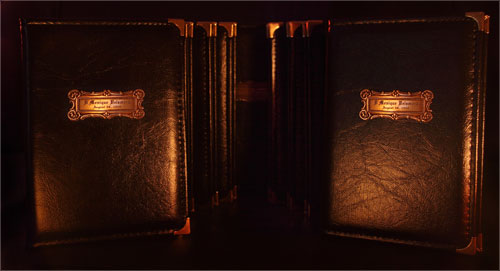 The first rite performed during three nocturnes 29 May - 1 June ov 2009.
The first rite performed during three nocturnes 29 May - 1 June ov 2009.
First edition limited to 5 unique copies released on 8 August 2009 and spread between underground entities. Remixed in May of 2010. Special edition of 13 collectors copies. Regular edition is 1087 copies.
IMPORTANT NOTICE:
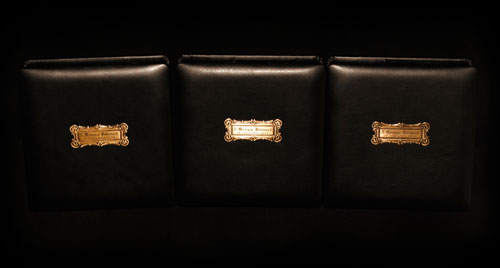
Change of D'Monique Velsmord Special Edition packaging. From now the rest of Special copies of D'Monique Velsmord album are housed in slightly different black leather cases. These luxury soft padded square cases are thick enough in depth to house all extras including YIIIX tape with case, and have a tiny screw inside that will hold the disks in place. New cases also include single photograph of V·.·D·.·W·.·V·.· attached inside (in every case unique). The price is the same €27.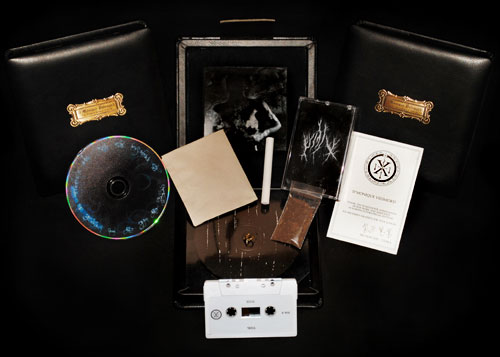
Full-length Audio CD Tracklist:
I. S/T [65:13]
Highly recommended to enthusiasts of graveyard isolationism and the blackest of black ambient sound; fans of anything else on Section XIII·.·COMA will definitely want to pick this up as well. Released in a hand-numbered edition of 1100 copies in slim dvd style packaging with full color artwork.
Reviewed by Crucial Blast
Upon listening to D’Monique Velsmord, one is caressed by atmospheric waves of isolation, synchronized with death rattling drones against the static silence; like that of a heart beating in despair... Echoes of a funeral ever since departed illuminate a somber spectrum of loneliness, exhuming obscured madness in a frenzy of wailing cries.Drones of anguish with bleak undertones of death pierce through the remnants of mania: an empty void liberating forgotten grief to entomb the listener in an aching trance, to reminisce in sorrow. Death knells chiming in ghostly echoes evoke a state of suspended gloom; the funeral chants on in desolation while those in mourning have transcended into decadent putrescence. A lingering death in the void evokes a lust for slumber in oblivion, blissful catatonia…
Turmoil erupts in tormenting ripples, enshrouding the quiescence in rage: compelling the psyche to writhe in agony as demonic cackles kindle forsaken atrocities from the depths of a murderous soul. Murmurs of death immerge in gloom, easing the transient madness, evoking tranquility into the dreary void. Akin to weeping the last tear, moribund gasps sustain the bane of existence, while madness haunts the unconscious in slumber.
D’Monique Velsmord embodies the essence of grief, a melancholic funeral dirge embracing the bleeding hues of emotion in isolation; the serenity in solitude…
Reviewed by Ellamorte
Videl Velsmord è l’‘ennesimo artista che vi proponiamo dallo scurissimo catalogo Section XIII, ma chi è Videl? Innanzitutto un visionario del “nero”, un artista a tutto tondo che in musica, grafica, video, riversa ogni sua concezione di mondi ai nostri occhi torbidi, soffocanti e glaciali, mondi per cui il sentimento è un lusso, ogni forma di vita è apparente ed uscita forse da incubi, forse da porte dimensionali aperte con chissà quali formule cabalistiche, esoteriche, un figlio moderno dell’‘antica magia alchemica e rituale, come può esserlo la musica in questi ambiti, se la ricerca è raffinata…Videl è allora personaggio ideale per divenire un po’‘ il concept-man, l’‘appendice intellettuale di Section XIII: Coma; se avete fatto vostri i cofanetti che in precedenti pagine vi abbiamo consigliato avrete notato che la parte grafica di booklet o cover è spesso un parto della sua mente anche grafica.
Se ripensiamo a Section non come una label ma come quel polveroso negozio in cui incontrare libri antichi da divorare, prima che ci divorino, ecco allora Videl esserne il venditore, colui che ci propone psichicamente la lettura, l’‘ascolto, psichicamente perché forse in lui la percezione di ciò che noi cerchiamo è forte, l’‘esorcismo mentale che vorremo è sua prerogativa ed il libro di oggi, il libro sonoro, è proprio di sua competenza, un unico capitolo, un’‘unica traccia che oltrepassa l’‘ora d’‘ascolto ma che se chiudendo gli occhi vi lasciate da noi guidare in questo nuovo universo parallelo, potrebbe durare anche mesi, secoli, il tempo rimane fuori, qui non serve, la dimensione è diversa, benvenuti nel mondo di “D’‘Monique Velsmord”.
Potrebbe di nuovo essere il racconto di un incontro, l’‘inizio sordo tra cupi rimbombi è il sentore di una porta enorme ed antica e qualcuno bussa con forza per potervi entrare, sarebbe l’‘ennesima storia in cui vi trasciniamo dove la curiosità porta in quei luoghi dove a priori si sa che off limit non è una dissuasione ma un sincero, amichevole consiglio di sopravvivenza. Potrebbe essere allora che il portone si apra, il grande uscio di vecchio legno e cardini in rugginoso ferro scuro si spalanchi risucchiandoci in un antro dove il raziocinio è stato divorato dal Male e una nuova ottica di sopravvivenza, anche mentale, si impadronirebbe di noi facendo scattare atavici istinti di sopravvivenza animala.
Ma se invece questa lunga traccia di un’‘ora la rivediamo sotto un’‘altra prospettiva, immaginiamo che quel Coma presente nel nome della label dove Videl è protagonista, intelligenza attiva, il portone non è più legnoso ma è ora osso, qualcuno bussa alle tempie per entrare nella dimensione più recondita dell’‘uomo, un luogo dove nemmeno la scienza riesce ad arrivare se non casualmente: il coma.
Hanno così un valore aumentato le stasi droniche, i cupi rimbombi, le percezioni vocali di inumana grevità perché vissute altrove, una sorta di prigionia non voluta, farmacologica, traumatica che nel finale è arida, il suono si riduce all’‘esistenza dello stand-by biologico, uno stand by dove scompare totalmente la percezione di tempo, rimane l’‘attesa da consumare interpretando questo status alterato della ragione.
Dark ambient è interpretazione ed in Sounds Behind The Corner la volontà regina è quella di sforzarvi ad andare oltre alla passività, ascoltare per capire, interpretare, immedesimarsi attivamente con l’‘artista per dare valore e senso all’‘opera, così è anche in questa situazione, ascoltando la scura, buia oltre maniera mono-traccia di Videl.
Rileggendo allora questa personale interpretazione l’‘istinto mi porta a dedicare questa pagina a tutti coloro che cercano di riportare nella dimensione del quotidiano che vive il coma come situazione non voluta, buon lavoro a tutti loro quando, tra frustrazioni e sparuti successi, tentano quotidianamente di spalancare gli antichi portoni del cervello.
Review by Nicola Tenani @ SoundsBehindTheCorner
| Up to 5 copies | 6 - 12 copies | 13 and more |
| 5 EUR | 4 EUR | 3 EUR |
[SXIIICD001] GATE TO VOID - BLACK EMPTY VOID I
 Genre: Deathscapes | Black Ambient
Genre: Deathscapes | Black Ambient
Release Date: 29 July 2010
Edition: 200 copies
Regular Edition: Black slimline DVD case + insert + audio CD.
Special Edition: Handmade black acrylic painted folding pack + melted black candle + incense + insert + thank you insert + audio CD + Bone jewellery. Housed in black velvet.
Click cover to see the packaging.
Limited edition of 111 CD copies available in special collectors packaging and regular edition. Production of special edition involved contribution of guest artists of The Order of the Black Wolf for bone jewellery and V.D.W.V. for hand-made packaging and design. Special edition limited to 13 copies.
Special Thank You to Emi Vaičiūnaitė for sporadic support in production and ideas.
Audio CD Tracklist:
I [16:12]
II [27:03]
III [01:31]
Full Length: 44:48
The first rite draws the veil to an abyss of sheer blackness with a melody that one might hear at the very moment of death. It is the sound of euphoria from the eternal void, if such a sound were perceptible by those in transition. Once enveloped by the blissful atmosphere of death, echoes of emptiness and isolation further induce a dark trance, as the maleficence of the darkness slowly unveils itself through the wailing of a lingering evil in the void.
With the second rite, an atmosphere of somber madness devours the melancholia of the first rite. Drones of torturous insanity entomb the listener in a state of painful decay while death rattling gasps invoke a sense of despair and suffering into the absolute depths of nothingness. This rite illuminates the bleakness of mortality, and ignites the passage towards ultimate nullity in the darkest of flames.
The final rite conjures an agonizing atmosphere of imminent death before entering into infinite darkness. A last breath exhales in macabre harmony with grim howls of torment, instilling a sense of utter desolation upon the recesses of the mind. Hypnotic deathscapes with elements of pure incomprehensible madness deteriorate the remaining essence of life from this distorted existence, and lead to the peaceful silence of death.
Black Empty Void evokes an atmosphere worthy of Thanatos, manifesting pure death energy to extinguish the cosmic illusion of existence through the darkest of black ambience.
Reviewed by Ellamorte
My first thought upon opening the package and seeing the cover was "This has to be inspired by MZ. 412." The clearly thought through cover lists the tracks as ritual I, II and III, and the aesthetic is cleary a nod to early black metal, so the comparison is unavoidable. You can imagine my surprise when I popped the cd in the player and heard slow soothing synthesizer strings and bird tweets coming out of the speaker. It was however a very pleasant surprise. I love being served something entirely unexpected. It doesn't take long before the music gets darker though, but the first track never loses the warmth from the beginning. Good music for dreaming, which is kind of strange for a release featuring a black and white skull on its cover.The second track carries over the extreme minimalism, but ventures deeper into the dark. The lengthy track consists mostly of echoes of various sounds, and it wouldn't be wrong to say that the emptiness enveloping these echoes is the most noticable feature of the track. It's like listening to someone sitting in a very large hall, with just a tiny pebble to bang against the floor to make music, but amplified to fill the space. The second track is the longest one of the three at nearly 30 minutes, but like the first one the duration is just right, and certainly couldn't have been any shorter.
The third track is much shorter than the first two, and also a collaborative piece between the mysterious person behind Gate to Void – only credited as M, and someone credited as Mournful. The third track is a sharp departure from the two first tracks, both in tempo and instrumentation, and serves to reawake the listener from the trance inducing minimalism. After the two previous tracks it feels incredibly short, and a little out of place.
The music is noticably introvert, and makes very few assumptions on the listener's behalf. There is very little over communication going in, in favor of manipulation of the subconscious. The title of the album is a good place to begin for an interpretation: black empty void. To me the music is about emptiness, which is even further emphasized by the lack of track titles and information in general – both on the cd cover, and in the music itself. It's deeply minimalistic, and reminds me a great deal of Deathprod in warmth and tempo, but Gate to Void is less restrained and strict. Considering the description of the project on myspace, and M's interest in altered states I guess it's appropriate to call the recording a psychonaut's journey through the inner space of the mind. As such the recording is obviously successful.
The sound is mostly crisp, but I do find myself wondering at times if the slightly rumbling bass is intentional or a result of poor equalizing. Usually I don't really mind, but in the case of the second track the ever present hum of a jack output detracts somewhat from the total experience.
It's a good album in general, but it is a bit anonymous. It's relaxing, and meditative, but I fear also easily forgotten. This is unfortunate, considering the artistic effort one can clearly see behind the product. I would recommend Black Empty Void for its relaxing qualities, but if you're not a big fan of the genre I'm afraid it might not do very much for you.
Reviewed by Gird_09@Kaliglimmer
Wer braucht schon nähere Angaben zum Künstler, wen die Musik stimmt? – ungefähr so lautet die treffende Kurzbeschreibung von “Black Empty Void” von Gate To Void, dessen Ursprungsland (Spanien oder doch Aus- tralien?) nicht einwandfrei zu ermitteln ist, wo Herr M. in 2009 drei ri- tuelle (Dark) Ambient Collagen konzipierte, die ein Gefühl der totalen Schwerelosigkeit vermitteln."Black Empty Void” erblickte in Großbritannien bei Section XIII·.·COMA das Licht der Welt, eine junge Tonträger- manufaktur, welche mir bisher gänzlich unbekannt war, die sich aber wohl auf das Verlegen von Dark Ambient (+ Artverwandtes) Release spezialisieren will, wenn man die heimische Webseite genauer unter die Lupe nimmt. Section XIII·.·COMA öffnen ihre Tore mit Gate To Void, der in einer limitierten Auflage von 111 Exemplaren + 13 Special Editions erscheinen soll, bloß auf dem Rücken der schwarzweißen Verpackung steht “…/ 200″ – Komisch, oder?
Unsere Welt inklusive der Gesellschaft befindet sich in einem rasanten Sturzflug in den Abgrund, weshalb extrem misanthropische Veröffentlichungen wie “Black Empty Void” keine Besonderheit darstellen, außer sie/ er rennt mit “”Scheuklappen & Ohropax” durch die Welt und erfasst Dinge wie Verdummung der menschlichen Spezies, Weltwirtschaftskrise, Krieg usw. nicht, die perfekte inhaltliche “Steilvorlagen” für Akteure wie Gate To Void bilden. Heißt, im Endeffekt zeichnet M. hier ein Abbild unser degenerierten Population, deren geistiges Niveau immer mehr sinkt, wodurch wir uns schlussendlich selbst ausrotten.
Musikalisch hüllt das Ein-Mann Projekt eben diese zunehmende Leere der Weltbevölkerung in tief atmosphärische (Dark) Ambient Wände, die zum Teil über Reminiszenzen an indische(?) Mantras verfügen, weshalb sich beim Konsum ein gewisse Schwerelosigkeit entwickelt, aus der die Hörerschaft nur mittels eingepflegter Sprach- & Tonsamples erwacht, womit der Protagonist “Black Empty Void” akzentuierte. PS: Personen, welche die überladenen Sounds favorisieren, sollten von dieser aufs Wesentliche reduzierte Arbeit die Finger lassen, an der sich für einen Track auch der US Amerikaner The Order of the Black Wolf beteiligte.
Gate To Void präsentiert mit “Black Empty Void” innerhalb des riesigen (Dark) Ambient Kosmos eine recht eigenständiges Werk, das besonders Freunde von Penjaga Insaf, Hall Of Mirrors & Sunn O))) antesten müssen – erwartet keine Ähnlichkeiten sondern ausschließlich Anlehnung, dann passt die Beschreibung – Danke!
Fazit:
Individuen, die innerhalb der alljährlichen Releasefluten nach Besonderheiten suchen, sollten sich “Black Empty Void” von Gate To Void nicht entgehen lassen – meine absolute Empfehlung!
Reviewed by kulturterrorismus
| Up to 5 copies | 6 - 12 copies | 13 and more |
| 5 EUR | 4 EUR | 3 EUR |
